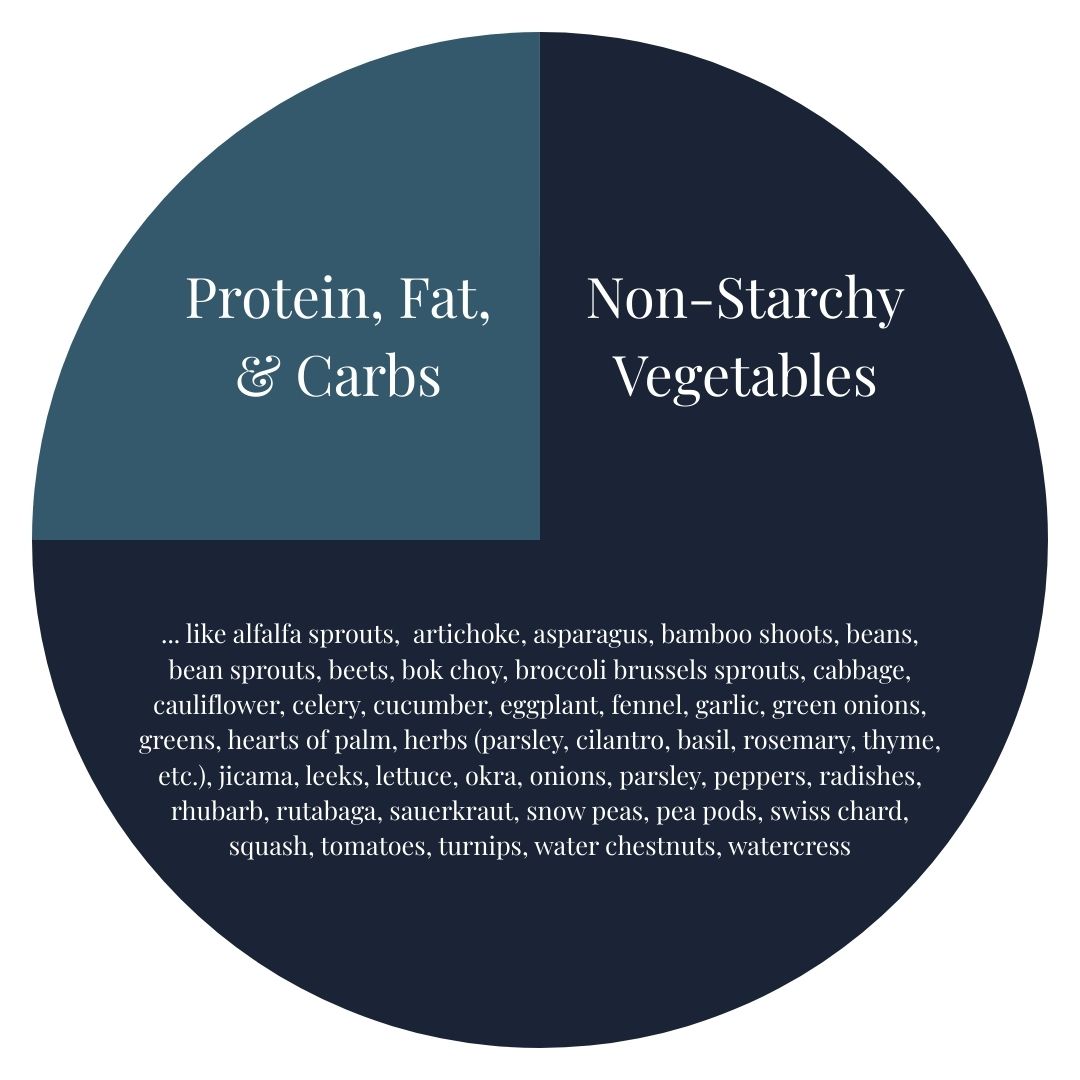 Many people want to eat nutrient-dense foods but struggle to make it happen. Finding a way to fit healthy eating into your lifestyle is crucial.
Many people want to eat nutrient-dense foods but struggle to make it happen. Finding a way to fit healthy eating into your lifestyle is crucial.
Some people love to cook, but fancy recipes and expensive ingredients do not work for everyone. Busy people need something fast; foodies need something especially tasty, and those who do not like to cook need something easy.
The following tips will be helpful for anyone because you can adapt the basic principles to meet your needs.
A Basic Plan for Lunch & Dinner

- Non-starchy vegetables should make up three-fourths of your plate.
- Add a serving of protein about the size of the palm of your hand.
- Add healthy fat like oil the size of your thumb (olive oil, coconut oil, flax oil, avocado oil), one handful of nuts or seeds, half to a whole avocado, or one-third to one-half cup olives.
- Add one serving of carbohydrates (½-¾ cup) like pasta, bread, rice or other grains, fruit, starchy vegetables (sweet potato, carrots, beans/legumes, etc.)
- If you notice that you struggle with portion sizes, it can help to use a smaller plate at lunch and dinner.
Making Vegetables Taste Good
Many people think they do not like vegetables because they have not tasted them well-made. Roasting vegetables changed my life; the key is to use some fat. Not only does the fat make the vegetables taste delicious, but it is good for you. Check out this article that explains how eating vegetables with fat enables you to absorb the fat-soluble vitamins better.
Ingredients
- Vegetable(s) of choice
- 1-2 tbsp of fat of choice – coconut oil, butter, ghee, or animal fat (i.e., lard, beef tallow)
- Salt and pepper to taste
Directions
- Preheat oven to 425.
- Spoon fat onto a 9x13 glass pan or cookie sheet with rimmed edges, and place the pan in the oven to melt the fat.
- Cut vegetables into uniform pieces
- Mix vegetables in the melted fat and season with salt and pepper.
- Place vegetables in a single layer on the pan.
- Roast in the oven. Cooking time varies based on the vegetable. For heartier vegetables like broccoli, cauliflower, carrots, and sweet potatoes, cook for 25-30 minutes. Asparagus is 15-20, depending on the thickness. Look for the vegetables to soften (tender when forked) and start to brown on the edges.
- Remove the pan from the oven and let the veggies rest for 5-10 minutes on the hot pan. This helps them to crisp up a bit.
- If you want to make it really tasty, and you tolerate dairy well, serve it with butter.
Chopping Quickly by Hand
Another challenge to making healthy food is time. Learning to chop and dice vegetables is a game-changer. Cutting will go much faster with the proper knife, a little practice, and the following cutting trick. Many people feel more comfortable with smaller knives. But chopping will be more efficient with a big, sharp knife. It can be intimidating, but don’t let that hold you back from trying. Start slowly; before long, you will be chopping like a pro.
Now that you have a good knife for the job, here is a trick that is especially helpful for those circular vegetables - onion, zucchini, carrot, eggplant - that keep rolling around as you cut them.
- Cut the vegetable in half long ways
- Place the flat sides down, so the food doesn't roll away from you.
- Make quick slices lengthwise.
- Slice in the other direction, across all the strips.
- Use them in your recipe or eat them straight.
It takes time to master any skill. But the more you chop, the faster you’ll get! You can also use a food processor.
Simple Recipes for Protein
Now it is time to tackle your protein. You don't need a recipe; a little seasoning sprinkled on some meat before cooking will work fine. If you want to try something new, here are some easy recipes.
- Simple Salmon
- Tilapia Bake (or other white fish)
- Skillet Pork Tenderloin Recipe
- Roast a Whole Chicken
Salads
Another option for tasty vegetables is to make a salad; there's no need for a fancy recipe. Adding protein and fat to the salad will make it a complete meal.
- Grab a base (or combine several) - spinach, lettuce, sliced red or green cabbage, grated beets, beet greens, sliced fennel, Swiss chard, kale, shredded carrots, microgreens, cilantro, basil, mint, parsley, endive, or dandelion greens, etc.
- Add brightly colored chopped fruits and veggies on top - tomatoes, carrots, apples, pears, cucumber, zucchini, onion, shallot, avocado, oranges, blueberries, strawberries, raspberries, grapes, peaches, dried cranberries, shredded beets, broccoli, olives, mushrooms, etc
- Make it your main course by adding a protein (fish, chicken, steak, pork, eggs, almonds, walnuts, pistachios, pecans, sunflower seeds, pine nuts, cashews, hemp seeds, chia seeds, sesame seeds, and flax seeds are just a few ideas)
- Make it your main course by adding a fat - avocado, nuts, seeds, animal fats, etc. (or use the salad dressing suggestion below)
- Optional HomemadeDressing - Oil (1-2 T. olive OR avocado) + acid (1 T. lime juice, lemon juice, orange juice, grapefruit juice, apple cider vinegar, OR balsamic vinegar.) + optional add ins (salt, pepper, honey, mustard, berries like raspberries, garlic, dill, oregano, basil, parsley, rosemary, thyme, etc.)
Do you have some simple recipes to share? I would love to hear about them at your next appointment.
Dr. Jamie

